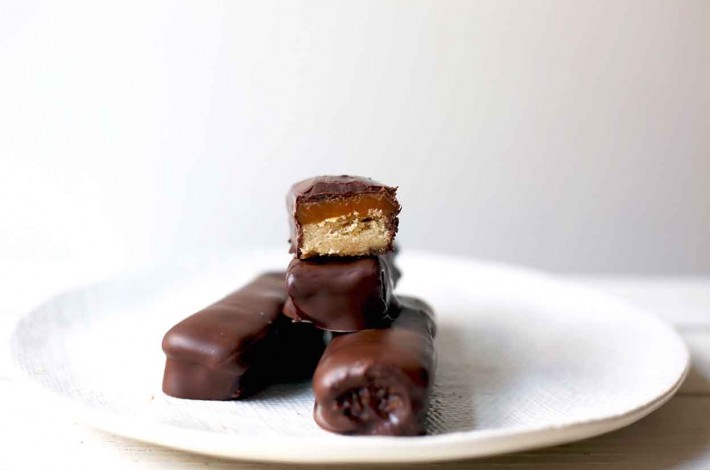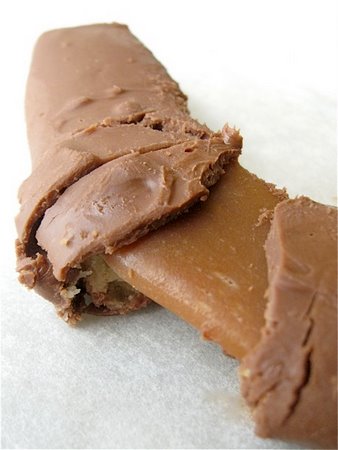


Have you ever baked something that made you do the Daffy Duck? You know, the cartoon scene where Daffy runs about yelling, "I'm rich, I'm rich, whoop, whoop, yippee, I'm rich!" He's bouncing around on his head, feet, hands, and rump in a spastic outpouring of sheer joy. Yep, the Daffy Duck.
Not everything we bake here in the kitchen gets us to do the Daffy Duck. Sometimes we do the swoon, the table grip (hold me Ralphie, I've died and gone to heaven). Susan Reid's creations often get me to do the swoon. That woman knows how to cook.
On a bad day, we do the wine taster (small taste and a spit) or the Emily Post (napkin over mouth, remove offending food, weak smile).
But on a really really good day, we do the Happy Dance (personal taste rules here;mine includes foot stomping and mmm mmm noises); and the Daffy Duck.
These Thousand Dollar Bars did just that for us here at KAF. The idea began with brainstorming blogs to go along with our annual sweepstakes. We wanted a recipe invoking richness. PJ suggested Mamie Eisenhower's Million Dollar Fudge (wonderful fudge, you can find the recipe online at the Eisenhower archives); and I started thinking about caramel and chocolate. Add a buttery shortbread crust, and we've got a golden ticket winner.
These bars definitely remind people of Twix® bars, both in shape and taste, but OH, so much better when top-end caramel and chocolate is used. Think of them as Twix® on Warren Buffett's budget.
So, break out your happy dancin' shoes, and let's make Thousand Dollar Bars.
Preheat the oven to 300°F. Lightly spray a 9” x 13” x 2” pan with cooking spray or line with parchment paper and set aside. If you want to top the bars with different chocolates, use two 8” square pans as I did here.
Place the flour, butter, sugar, and vanilla in the bowl of a stand mixer and blend on medium speed. At first the mixture will seem a bit dry.
Continue beating on medium speed, and the dough will come together as a soft, smooth, slightly sticky dough.
Place the dough in your chosen pan(s) and pat with your fingers to spread.
So, what is “best” to prevent the dough from sticking to your fingers? On the left I used cold water, on the right I used flour. As you can see, the flour pan is much smoother and more level, so I'd stick with flour for this one (no pun intended).
Prick the dough all over with a fork. This docking, as it's called, will allow steam to escape during the baking, and keep your shortbread from bubbling up in patches.
Bake the shortbread for 35 to 45 minutes, until lightly brown around the edges.
While the crust is baking, make the caramel layer. Place the caramel and cream in a medium-sized saucepan and melt together over low heat, stirring frequently.
The caramel will be glossy and lump-free, but still thick.
When you raise your spoon or spatula, the caramel should pour off in a thick ribbon.
Pour the warm caramel over the baked, cooled crust and spread to the edges carefully. If the crust is too warm, it may break and shatter, leaving crumbs in your caramel. Not a total disaster, but avoidable with a cooled crust.
Place the pan(s) in the refrigerator to set the caramel layer. Small square pans can be stacked if offset, saving you valuable fridge space.
After the caramel has chilled for about 30 minutes, melt the chocolate for coating. I used milk chocolate for one 8” pan, and dark chocolate candy coating wafers for the other.
You can use a double boiler to melt the chocolate; or microwave in short bursts to avoid scorching the chocolate.
If the chocolate seems too thick, melt in 1 teaspoon of vegetable shortening at a time, until it's thin enough to coat the bars. I didn't try chocolate chips as a topping. They should work as a layer, but not so well for dipping.
For the quickest approach, simply pour the melted chocolate over the caramel layer and return to the fridge until set. Cut and serve the bars as you would brownies. Keep in mind that the caramel has been thinned down and will get lovely and soft and melt-y at room temperature, so you may want to cut pieces about 10 minutes before serving.
If you'd like to make classic Twix®-haped bars, remove the caramel-coated shortbread from the pan. Be sure to use parchment in the pan if you're planning to do this, as it will make removing the bars 1,000 times easier.
Cut the bars down the center lengthwise, then cut each half into "fingers". You can make them as thick as you like, but remember: if they're too thin, they'll break as you try to coat them in chocolate.
Drop the sticks into the melted chocolate one at a time. Using a deep bowl will help keep your chocolate deep for dipping, too.
Submerge the stick under the chocolate until well coated. Using two forks to lift and support the stick will keep it from breaking as the excess chocolate drips off. Gentle tapping on the side of the bowl will help, too.
Place the coated bars on a wire rack to finish setting up. Parchment paper placed under the rack will catch any wayward drips. After about 20 minutes you can transfer the bars to parchment paper, to set completely.
Sweet chocolate, sensuous caramel, the crisp snap of the shortbread. A little dribble on your chin, a lot of finger licking, and oh yeah, don't forget the Daffy Duck!
Please bake, rate, and review our recipe for Thousand Dollar Bars.


















